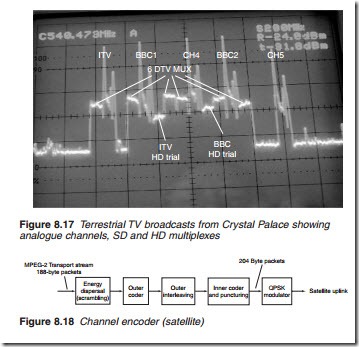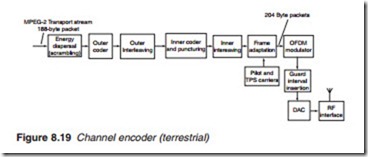High definition terrestrial television
In 2006, both the BBC and ITV started HD terrestrial broadcasts on a trial basis from Crystal Palace: channel 27 for the ITV and 31 for the BBC (Figure 8.17). Each HD multiplex occupied a standard 8 MHz bandwidth using 8K mode, 64-QAM, code rate 2/3 and a guard period of 1/32. A lower transmission power (10 dB below SD) was used to avoid any interference with adjacent analogue and digital channels.
Satellite channel encoder
Figure 8.18 shows the main components of a satellite DTV transmission sys- tem. The input signal is a multiplexed MPEG-2 transport stream consisting of 188-byte packets. The signal is first randomised with a pseudo-random bit sequencer, for energy dispersal. The Reed–Solomon coding RS (204, 188)
adds 16 bytes of error protection data to the packet, making a total of 204 bytes. There are then interleaved before entering the inner coder. The inner coder employs convolutional coding with a mother code rate of 1/2. The convolutional code is then punctured to produce a code rate of 2/3, 3/4, 5/6 or 7/8 as determined by the service provider. The error-protected packets are now ready for the QPSK modulator before entering the satellite uplink interface for transmission to the transponder.

